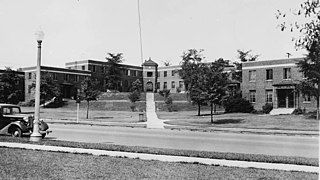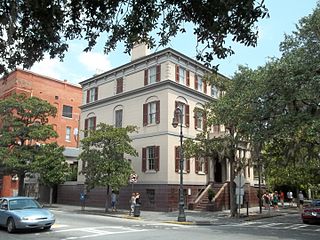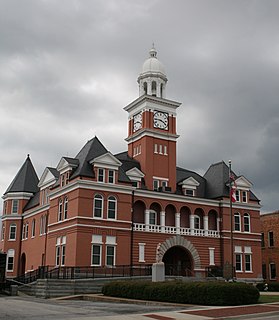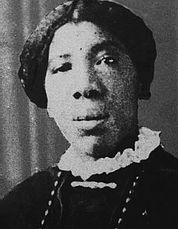
Elbert County is a county located in the northeastern part of the U.S. state of Georgia. As of the 2010 census, the population was 20,166. The county seat is Elberton. The county was established on December 10, 1790, and was named for Samuel Elbert.

Elberton is the largest city in Elbert County, Georgia, United States. The population was 4,653 at the 2010 census. The city is the county seat of Elbert County.

Joseph Rucker Lamar was an Associate Justice of the United States Supreme Court appointed by President William Howard Taft. A cousin of former associate justice Lucius Lamar, he served from 1911 until his death in 1916.

Watson Mill Bridge State Park is a 1,018-acre (4.12 km2) Georgia state park located near Comer and Carlton on the South Fork of the Broad River. The park is named for the Watson Mill Bridge, the longest original-site covered bridge in Georgia, which spans 229 feet (70 m) across the South Fork of the Broad River. The site is listed on the National Register of Historic Places as the Watson Mill Covered Bridge and Mill Historic District. The bridge, built in 1885, is supported by a Town lattice truss system held together with wooden pegs also known as trunnels. Georgia once had over 200 covered bridges, but only 20 now remain. The park also offers a scenic nature trail and a new hiking/riding trail that winds through the thick forests and along the rivers edge.

Techwood Homes was an early public housing project in the United States, opened just before the First Houses. Located in Atlanta, Georgia, it replaced an integrated settlement of low-income people known as Tanyard Bottom or Tech Flats. It was completed on August 15, 1936, but was dedicated on November 29 of the previous year by U.S. President Franklin D. Roosevelt. The new whites-only apartments included bathtubs and electric ranges in each unit, 189 of which had garages. Central laundry facilities, a kindergarten and a library were also provided. Techwood Homes was demolished in advance of the 1996 Olympics and is now Centennial Place Apartments.

Chickamauga and Chattanooga National Military Park, located in northern Georgia and southeastern Tennessee, preserves the sites of two major battles of the American Civil War: the Battle of Chickamauga and the Siege of Chattanooga. A detailed history of the park's development was provided by the National Park Service in 1998.

The Georgia State Railroad Museum is a museum in Savannah, Georgia located at a historic Central of Georgia Railway site. It includes parts of the Central of Georgia Railway: Savannah Shops and Terminal Facilities National Historic Landmark District. The complex is considered the most complete antebellum railroad complex in the United States. The museum, located at 655 Louisville Road, is part of a historic district included in the National Register of Historic Places.

Central of Georgia Depot and Trainshed is a former passenger depot and trainshed constructed in 1860 by the Central of Georgia Railway (CofG) before the outbreak of the American Civil War. This pair of buildings was declared a National Historic Landmark in 1976, a listing that was expanded in 1978 to the old Central of Georgia Railway Savannah Shops and Terminal Facilities.

Juliette Gordon Low Historic District consists of three buildings—the Juliette Gordon Low Birthplace (also known as Wayne-Gordon House, First Girl Scout Headquarters, which was the carriage house for the Andrew Low House, converted for use by the Girl Scouts in May–June 1912, and said Andrew Low Carriage House, is a site in Savannah, Georgia, significant for its association with Juliette Gordon Low and the founding of the Girl Scouts of the USA.

Meadow Garden is a historic house museum at 1320 Independence Drive in Augusta, Georgia. It was a home of George Walton (1749–1804), one of Georgia's three signers of the U.S. Declaration of Independence, and later a governor of Georgia and a United States Senator. Meadow Garden was saved and established as a museum by the Daughters of the American Revolution in 1901. It was declared a National Historic Landmark in 1981.

Augusta Downtown Historic District is a historic district that encompasses most of Downtown Augusta, Georgia and its pre-Civil War area.

The Elbert P. Tuttle U.S. Court of Appeals Building, also known as U.S. Post Office and Courthouse, is a historic Renaissance Revival style courthouse located in the Fairlie-Poplar district of Downtown Atlanta in Fulton County, Georgia. It is the courthouse for the United States Court of Appeals for the Eleventh Circuit.
Rucker House may refer to:
The Granite Bowl is the off-campus playing venue for the football and soccer sports teams for the Elbert County Blue Devils in Elberton, Georgia, in the United States. It is located between College Avenue and West Church Street and is near the city of Elberton's downtown square. The stadium can hold up to 20,000 people and is made almost entirely out of granite. The Granite Bowl has been listed as an important historic site by the Georgia Trust for Historic Preservation and is considered by many to be the jewel of Elbert County.
Rucker's Bottom Site (9EB91) is an archaeological site in located on the Upper Savannah River in Elbert County, Georgia.

Elbert County Courthouse is a historic courthouse on Courthouse Square in downtown Elberton, Georgia, county seat of Elbert County, Georgia. The Romanesque Revival architecture building was designed by Reuben H. Hunt and constructed in 1894. It is featured on several postcards. It was listed on the National Register of Historic Places on September 18, 1980.
Ruckersville is an unincorporated community in Elbert County, in the U.S. state of Georgia.

Gospel Pilgrim Cemetery was founded in 1882 as a cemetery for African Americans in the 216th general militia district, Athens, Georgia area. Nine acres in size, it contains an estimated 3,500, mostly unmarked, graves.
The Georgia–Carolina Memorial Bridge was a highway crossing over the Savannah River between the states of Georgia and South Carolina that was in service from 1927 to 1981. The completion of this bridge marked the beginning of the end for Savannah River ferry traffic.

Beulah Rucker Oliver was an African-American educator from Banks County, Georgia. In 1915 she opened the Rucker Industrial School in Gainesville to teach African-Americans; Rucker oversaw its growth and served as principal for more than forty years.
















